White
Star - ill-fated Hospital Ship the HMHS Britannic
Please Note: Firefox and
Google Chrome are
not suitable - Use Internet
Explorer & old Google for this page to load
perfectly!

Click the
logo above to reach the ssMaritime FrontPage for News Updates & “Ship
of the Month”
With
Reuben Goossens
Maritime
Historian, Cruise‘n’Ship Reviewer, Author & Maritime Lecturer
Please
Note: All ssMaritime and other related
maritime/cruise sites are 100% non-commercial and privately owned. Be assured
that I am NOT associated with any shipping or cruise companies or any
travel/cruise agencies or any other organisations! Although the author has been
in the passenger shipping industry since 1960, although is now retired but
having completed over 700 Classic Liners and
Cargo-Passengers Ships features I trust these will continue to provide classic
ship enthusiasts the information the are seeking, but above all a great deal of
pleasure!
Reuben Goossens.
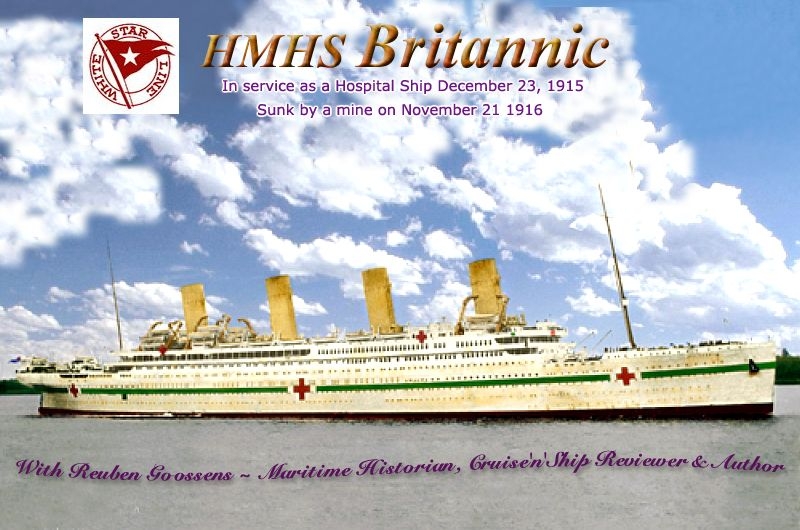
Images
are mostly from the author’s private collection unless otherwise noted
A
special thank you to superb maritime artist Ken
Marschall for his works on this page, please visit his Website at www.trans-atlanticdesigns.com
1… White Star Line:
The RMS Olympic was part of the
White Star Line and was owned by the British “Oceanic Steam Navigation
Company.” However, all of this company’s stock was owned by the
“International Navigation Company Ltd,” of England, which
in turn, was fully owned by the “International Mercantile Marine
Company” (IMMCO), which was an American Corporation.

Therefore White Star
Line and later Cunard Line may have been British operated, and Cunard still is
today, but in reality it is a wholly American owned company both then and now!
The only difference is that today Cunard Line is owned, by different American
company, being the Carnival corporation, or as most people know them to be -
Carnival Cruises, which is a massive company that now owns so many of the well-known
cruise brands, such as P&O Australia, P&O UK, Princess Cruises, Costa,
Aida and Seabourn Cruises, even the outstanding Dutch company Holland America
Line, and the list just goes on! Thus Carnival influences all these cruise
companies, and they are marketed by Carnival Plc!
2… Introduction to the Britannic:
The first of the Olympic Class
Trio to be built was of course the RMS Olympic, which turned out to be the only
liner of the three to have a long and successful life at sea and she was a much
loved ship by all that sailed on her, regardless the class they were in! The
RMS Titanic was as history has proven to be the ultimate disaster, and although
it was one of the most tragic of events with a huge loss of life, some good did
come out of it, as safety became more regulated. Very quickly both the Olympic
received a considerable refit with the strengthening of her hull and watertight
doors and other improvements, also a big change with additional lifeboats, and
thanks to the crew taking a tough stand on the collapsible lifeboats, they were
discarded and new ones obtained and far superior davits were installed, etc!
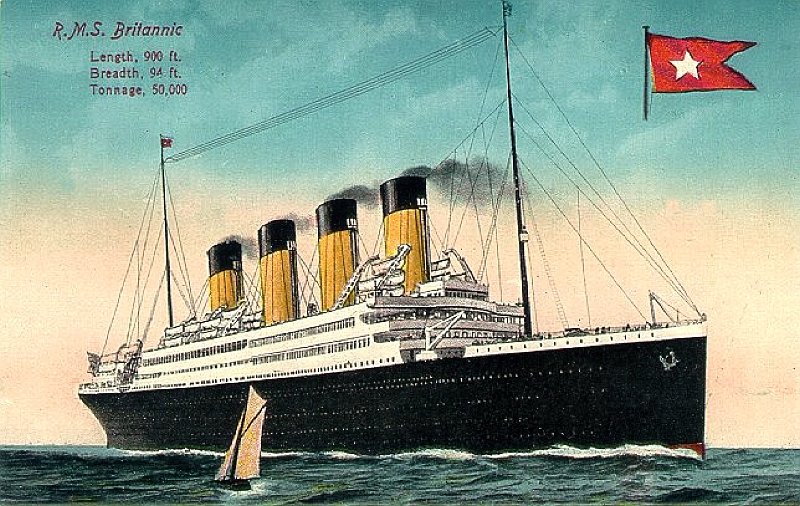
RMS
Britannic as she looked after she was completed and placed in storage in Belfast during the war,
before her call up
Note all the additional lifeboats
that she carried
Whist the building of the Britannic
was greatly delayed, which was due to the outcome of the court enquiry into the
Titanic disaster and due to the results of the enquiry many additional safety
features had to be added to the Britannic, even more than to the Olympic, which
was due to her having been built earlier and whilst this new ship was obviously
far more accessible!
Gigantic
or Britannic?
It has always been said that the
third ship was to be named the Gigantic and the story goes as thus: Before the
Titanic disaster, she was to be named the Gigantic, a name which would seem to
be in keeping with her sister’s names. However, White Star Line later
denied that she was to be called Gigantic and that late in May 1912 it was
announced that she would be named Britannic, a name that was considered
“lucky” due to the superb career of their first Britannic.
I must say however, that the truth is that one
way or another that the above has never been fully proved or disproved for that
matter. But at some stage there was a poster printed in the 1900s that showed
her clearly as the “Gigantic”, but the question begs who printed
it, for it does not say “White Star Line.” Thus I will leave it
open-ended and for you to make up your own mind!
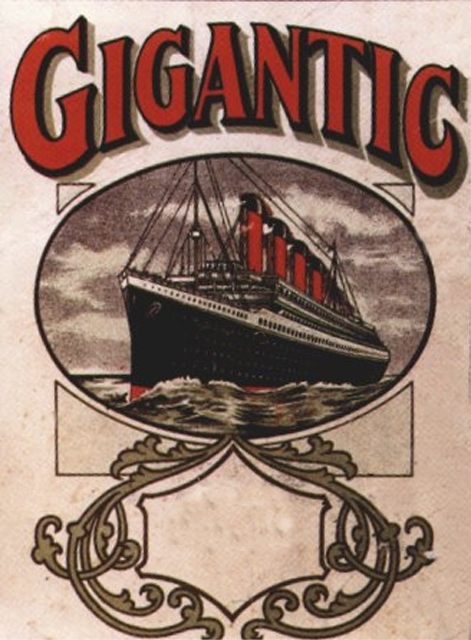
The
Britannic (Gigantic?) was the sister ship to the Olympic and Titanic, although
the three sisters never sailed on the North Atlantic
together
This, the third of the great White
Star Olympic class liners, the Britannic was also built by Harland & Wolff
in Belfast, in fact she was laid down in the very same yard the same slip where
Olympic had been built several years earlier. Laid down in November 1911, she
was extensively modified while still on the stocks to correct the fatal design
flaws that had contributed to Titanic's disaster. But, like her ill-fated
sister, Britannic was destined never to complete a single fare-carrying voyage
for her owner and, in fact, sank more quickly than Titanic even with her new
safety modifications.
3… Construction and Launching of the
Britannic:
Britannic’s
keel was laid on November 30, 1911 at the Harland and Wolff shipyard in Belfast. But due to
improvements introduced as a consequence of the sinking and the massive loss of
life of the Titanic, the Britannic would not be launched until 1914.
She was constructed in the same gantry slip
(#400) that was used to build RMS Olympic, thus by reusing the Olympics’
space saved the shipyard time and money by not having to clear out a third slip
similar in size to those used for Olympic and Titanic. In August 1914, before
Britannic could commence transatlantic service between New
York and Southampton, the First
World War began. Immediately, all shipyards with Admiralty contracts were given
top priority to use available raw materials. All civil contracts, including the
Britannic, with good reason slowed down.
Construction
Photographs
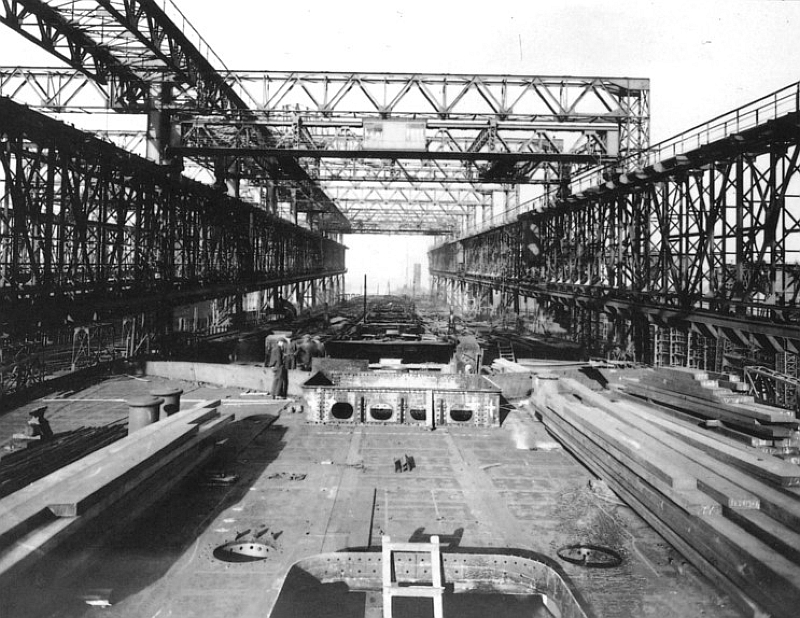
Here
we see one of her decks laid and work continues to build the third of the
Olympic Class liners!
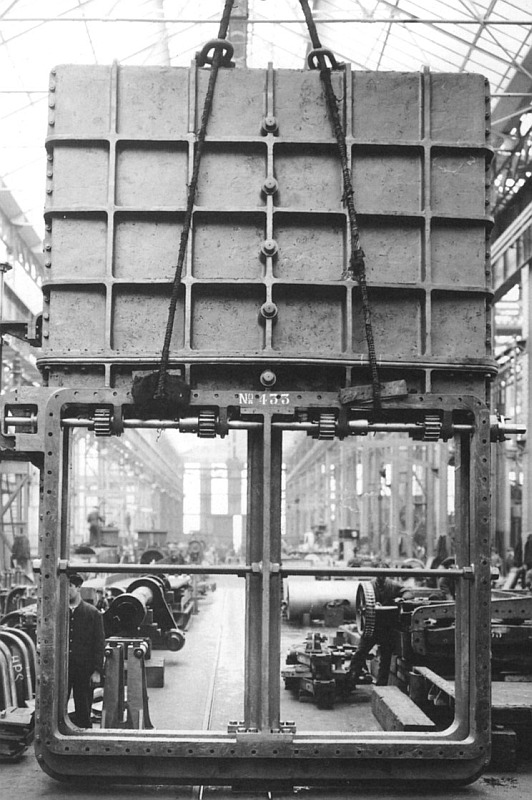
Here
we see one of her watertight doors
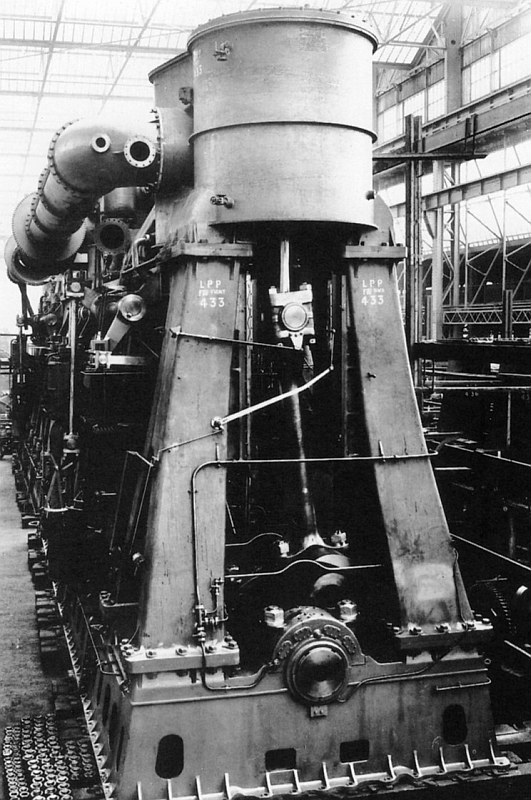
One
of Britannic's massive four cylinder triple expansion steam engines
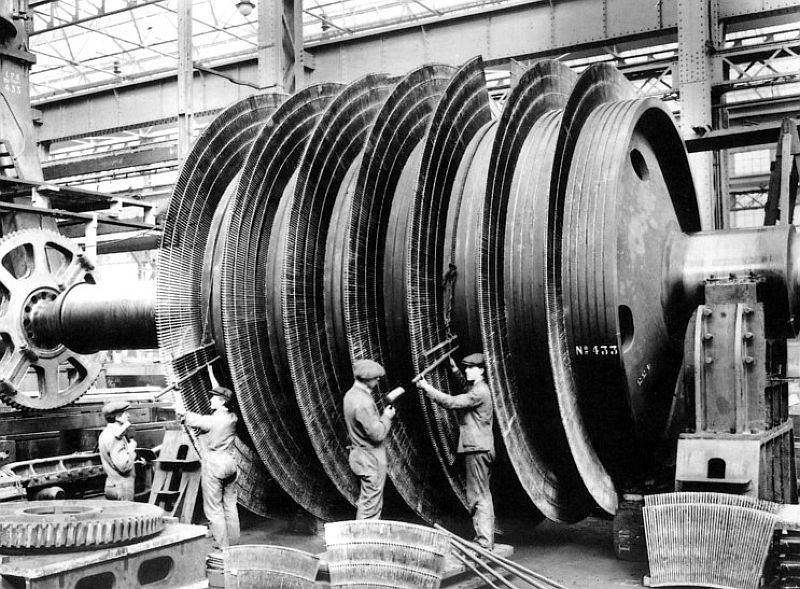
Here we
see her turbines being finished
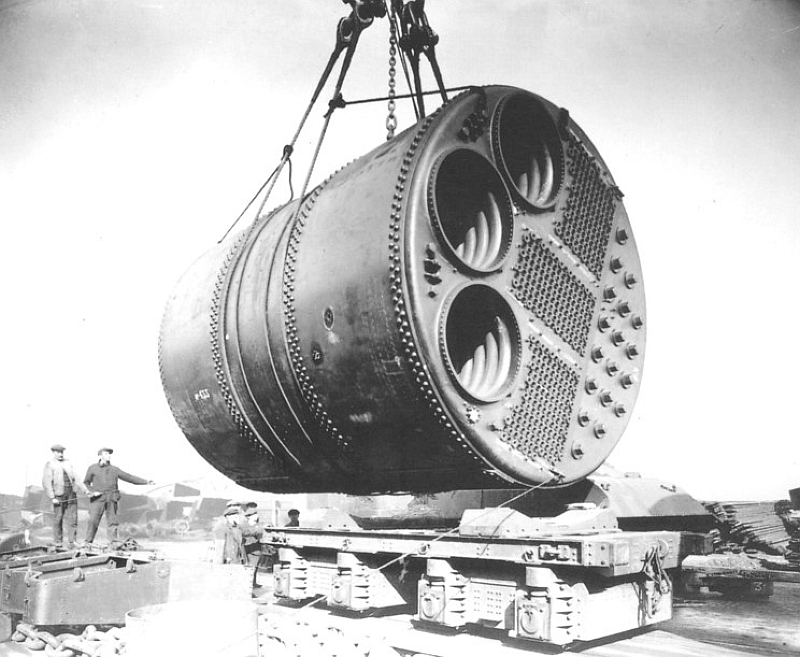
Here
we see one of 24 double-ended boilers
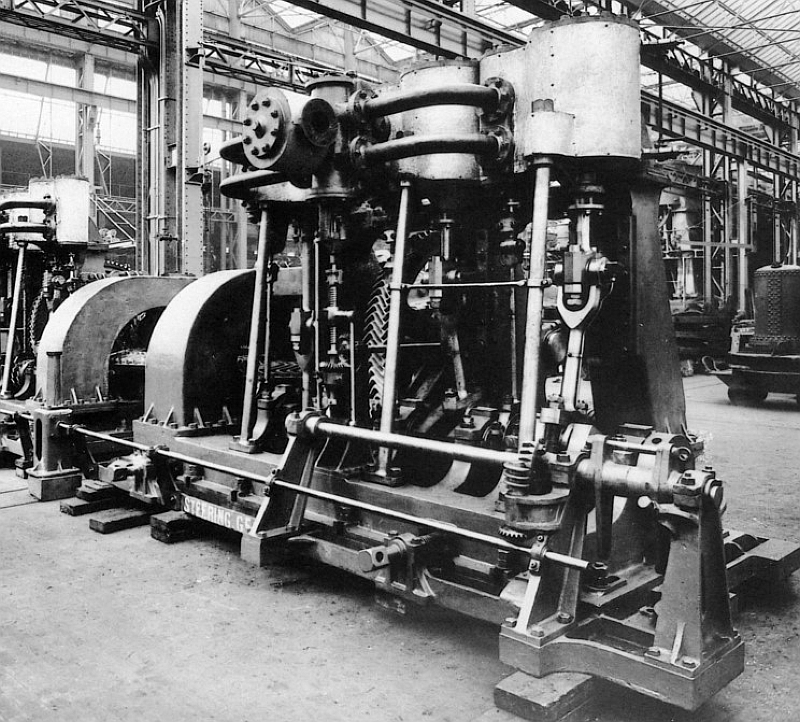
This
is the rudder’s steering turbine engine
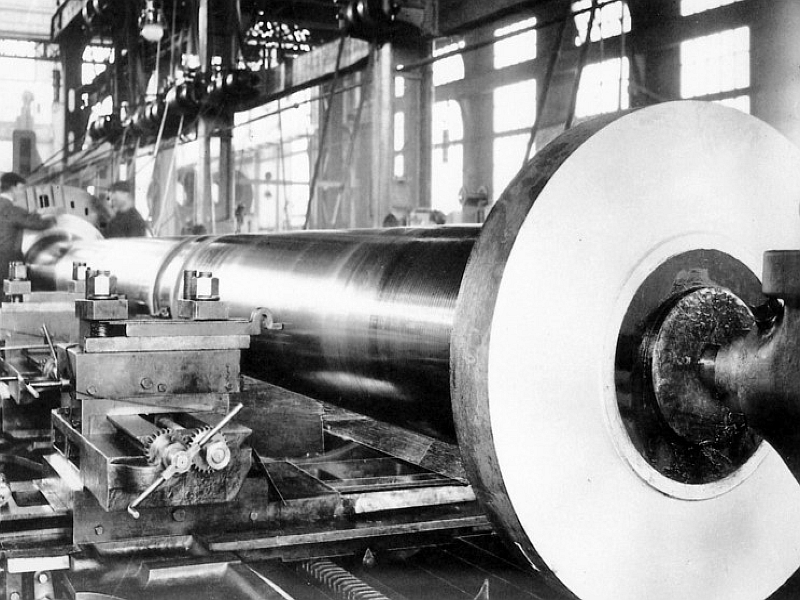
One
of Britannic’s propeller shafts
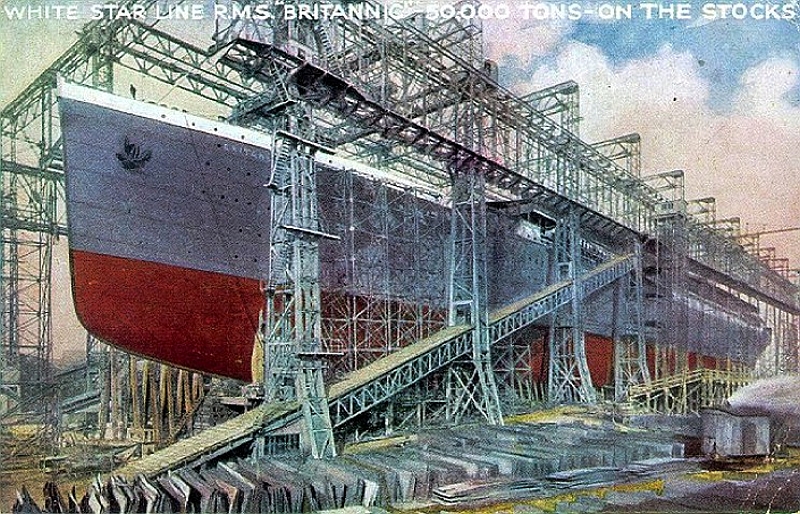
Britannic
nearing her launch-date as well as a great view of her Gantry!
This
is a rare colourised image
Source unknown
– Please see Photo notice at bottom of page
With her building having slowed
down due to the war, but once her hull and the main part of her superstructure
had been completed, except the Bridge and housing and funnels up on Boat Deck,
etc, the Britannic was launched with many White Star dignitaries present on
February 26, 1914, and she was towed to the Harland & Wolff fitting-out
berth to complete the Britannic.
Photographs
of the Launching
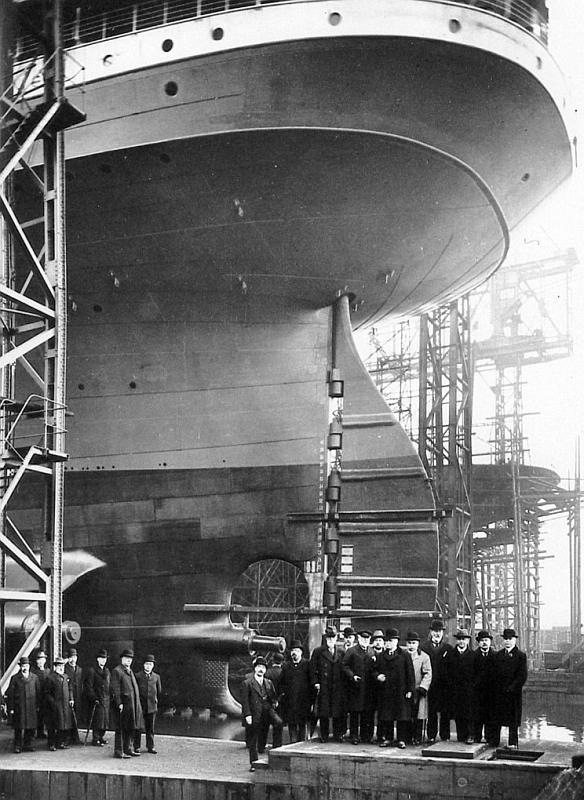
Below
her mighty stern we see a group of dignitaries just prior the launching on
February 26, 1914
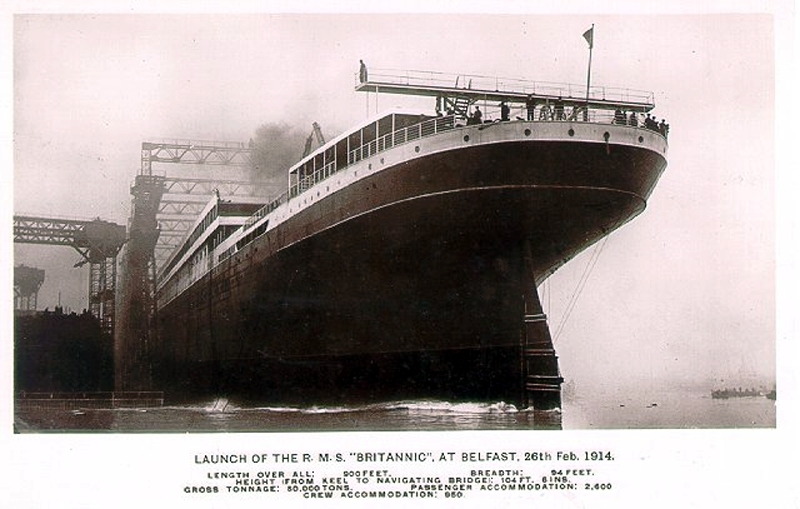
An
excellent view as she rolls off the blocks
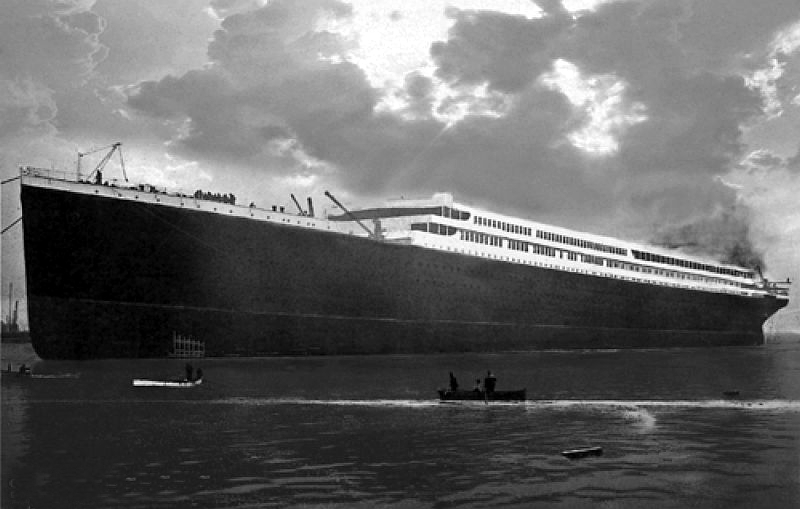
The great ship is finally afloat
and should be looking forward to a long future – BUT?
With the war having commenced,
the Admiralty began to requisition a large number of ships as armed merchant
cruisers or as troop transport ships. The problem however for the relevant
companies involved that the Admiralty was paying the companies for the use of
their vessels, but the risk of losing a ship during military operations was
considered to be very high. However, the big passenger liners were not taken
for direct military use, mostly because smaller ships were easier to manoeuvre
and operate. During this time, White Star decided to withdraw the RMS Olympic
from service until the danger on the Atlantic had passed, thus the Olympic
returned to Belfast
on November 3, 1914, while the fitting-out on her sister continued slowly.
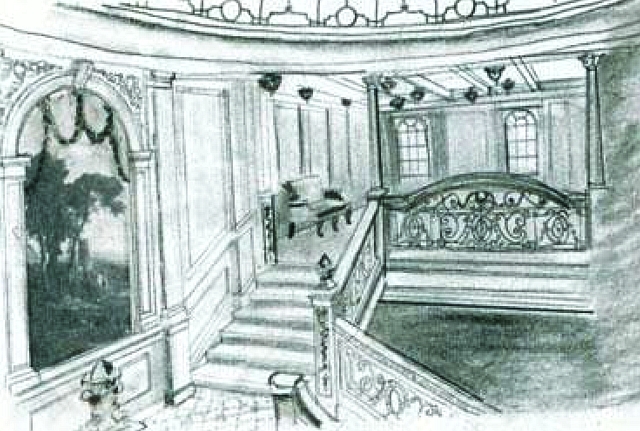
An
impression of Britannic’s First Class Staircase
Sent in by a
supporter but source unknown – Please see Photo notice at bottom of page
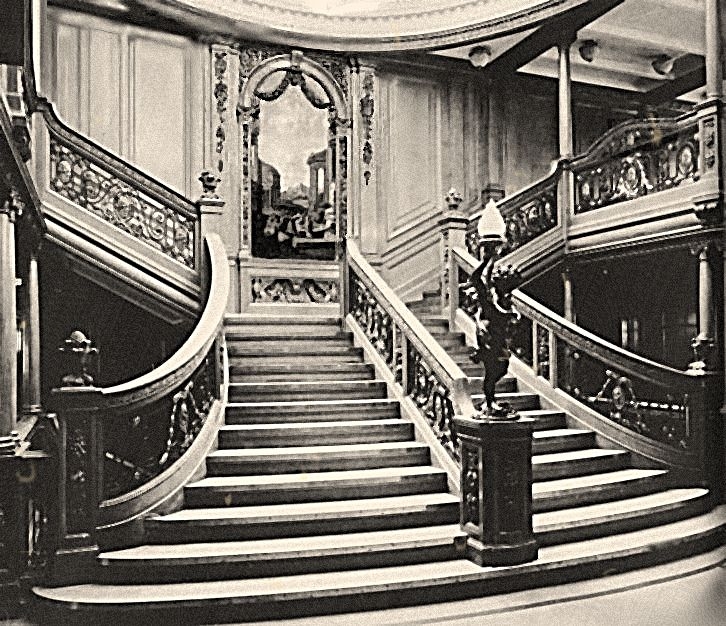
A very
rare image of the illustration that became a reality!
Slowly the fitting out of the
Britannic’s interiors were almost completed and she was looking good with
most of the same features of the Olympic, and her First Class Staircase had
another feature as is shown above, rather than a clock, as on the previous
sisters, she had a stunning painting surrounded by timber scrolls and elegant
decorations.
Although the ship was far from ready, but as
far back as in July 2, 1914 White Star Line had announced that the RMS
Britannic would commence her Southampton to New York service in the spring of 1915.
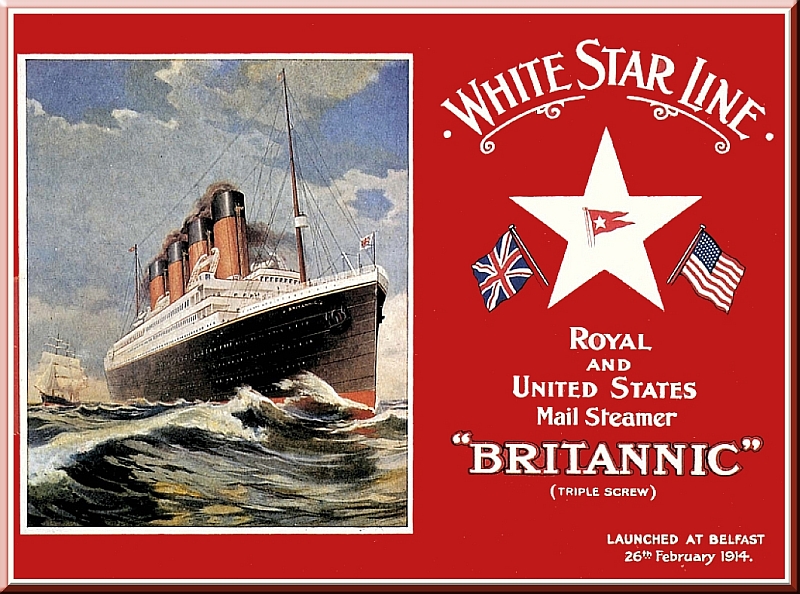
The
official White Star Poster that accompanied the announcement of her commencement
in spring 1915
However, White Star
was soon told that the ship may well be required and be used as a hospital
ship, and thus she was partially prepared for the job before she was even
officially requisitioned. In May 1915, she had her mooring trials of her
engines and she was now fully prepared for an emergency entrance into war
duties with as little as four weeks notice. Tragically it was in that very same
month on May 7, 1915 that the Cunard passenger liner RMS Lusitania was
torpedoed by a U-Boat some 18km from the Irish
coast and Old Head of Kinsale Lighthouse.
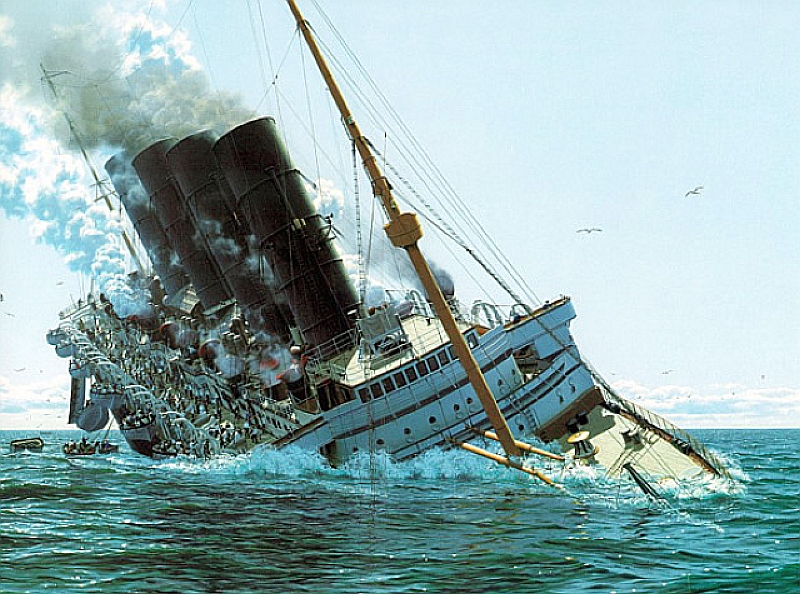
The
tragic final moments of the RMS Lusitania
above is © Copyright by Ken Marschall Visit Ken’s Web
Site at: www.trans-atlanticdesigns.com
German U-Boat number U-20 was under the command of Kapitänleutnant
Walter Schwieger, who was sent to attack British ships around the British
coast, and he was known to attack all kind of ships and he even fired at
neutral ships as he suspected that they may be British in disguise. In an
earlier voyage, he narrowly missed hitting a hospital ship with one of his
torpedoes. Thus his reckless reputation made it more likely for him to
torpedo a British passenger liner, such as the Lusitania. His evil act killed 1,198
innocent lives out of the 1,959 on board the RMS Lusitania with 761 survivors.
The world was stunned to hear about this atrocity, for it was the first time
ever that a passenger ship had been targeted and it was against all wartime
conventions!
With this horrid event having occurred the
Admiralty decided that there was an immediate need for additional and larger
tonnage and that operations would have to be extended into the Eastern Mediterranean and wherever it was needed!
Thus in June 1915, the British Admiralty
decided to requisition larger passenger liners for used as troop transports for
the Gallipoli campaign. The first to depart were the Cunard liners; HMT Mauretania
and HMT Aquitania. As the Gallipoli landings had proved to
be disastrous and the casualties were to say the least massive with countless
losses of Australian, New Zealand and British soldiers, in addition with
countless more wounded as it had been an unbelievable slaughter field, there
was a desperate need for large hospital ships to provide efficient treatments
and to aid in the evacuation of the wounded. For this reason the troopship, HMT
Aquitania would become a hospital ship in August, and the then in storage RMS
Olympic would take over from the Aquitania
and become a trooper from September 1915.
4… From Liner to Hospital Ship:
On November 13, 1915
the Britannic was officially requisitioned to become a hospital ship by the British
Admiralty. Thus as she was still in storage at Belfast, she had to return to
the Harland & Wolff yards and be rapidly made ready as a hospital ship with
facilities for some 3,300 beds, and her luxury fittings and furnishings were
removed and placed into storage, whilst other simpler furnishings were loaded
for use on board.
Senior medical staff such as officers, doctors
and senior registered nurses, etc would be accommodated in First Class
accommodations, whilst the rest would use Second Class and the best of Third
Class accommodations. The huge First Class Dinning Room became the ICU
“Intensive Care Unit”, whilst the adjoining Reception Lounge was
converted into a fully equipped operating theatre.
Public rooms and glazed in decks became large
dormitories for the wounded, and it was also convenient as their location would
always be close to their lifeboat stations should any emergency ever come
about. Thus, the Britannic became a full-scale hospital ship and upon
completion she was able to accommodate just over 3,300 wounded.
During this time she was also repainted in the
official “International Red Cross” livery, being all white with
three large red crosses on each side of her hull, as well as a green band.
Officially her Red Cross designation would give her safety in international
waters.

Here
we see the HMHS Britannic as she was seen in a movie
The Britannic arrived at
Liverpool from Belfast on December 12, which was a very big day for the ship,
for 1: Captain Bartlett, who had been the company’s marine superintendent
in Belfast whilst the Britannic was being built, boarded her on this day; 2:
She was officially commissioned as a hospital ship and given her Pennant Number
G 618 on this day. 3: Under the command of Captain Charles A. Bartlett
the Britannic took on board a comprehensive medical staff. made up of 52
officers and doctors, 101 nurses, 336 orderlies, and 675 male and female
crewmembers (although many crew had already boarded previously), making this a
big day for the ship! During the Britannic’s stay in Liverpool she took
on all her requirements such as food, supplies of various kinds, but most
importantly a massive amount of medical supply.
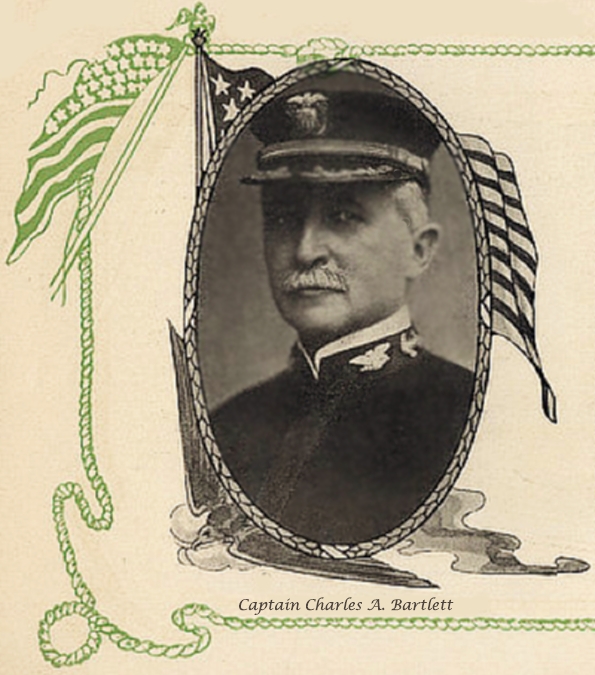
Captain
of the HMHS Britannic, Captain Charles A. Bartlett
5… HMHS Britannic’s
Career as a Hospital Ship:
Voyage 1: Her Maiden Departure.
December 28, 1915 - HMHS Britannic departed Liverpool
on her maiden departure bound for Mudros located on the Island of Lemnos,
Greece. She made a call at Naples Italy early in
the morning on December 28, where she would load coal and departed in the
afternoon and arrived in Mudros on December 31, where she took on board some
3,300 casualties. On January 3, 1916 she departed bound for Southampton
where she arrived on the 9th.
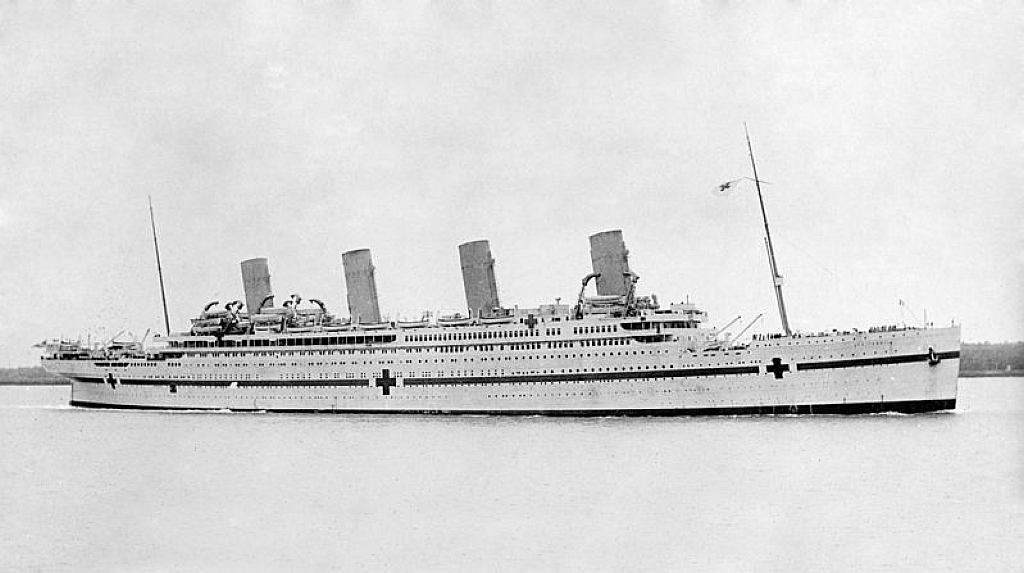
Here
we see the HMHS Britannic on her maiden departure
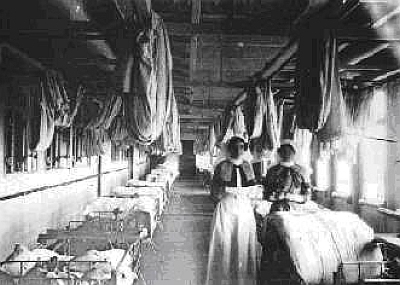
Here
we see two nurses at a ward set up along the deck space, during a voyage to
Lemnos or Naples
as it is empty
Voyage 2:
January 2, 1916 – she departed for her second voyage to Mudros and again
stopped at Naples.
However, this time she was held up in Naples
due to the countless casualties based on other ships. It was decided to
transfer thousands of these to the Britannic and she returned to the UK, rather than going on to Greece. She
arrived back in Southampton on February 9.
She remained in Southampton
for well over a month.
Voyage 3:
March 20 – Britannic departed this time for Augusta
in Sicily where she loaded casualties from
another ship and arrived back in Southampton
on April 4.
Having offloaded all casualties in April, she
was anchored off the Cowes, Isle
of Wight and she was used as a floating hospital as there was an
overload of casualties ashore. At the end of her mission there, she sailed for Belfast.
May 8 – Britannic arrived at Harland
& Wolff to be refitted as a passenger liner once again.
June 6 – Britannic is officially
released and returned to White Star Line, but she is laid up,
August 28 – The Britannic is
requisitioned once again by the Admiralty as a hospital ship and she made ready
once more and departs for Southampton.
Voyage 4:
September 24 – she departs Southampton Mudros, arriving in Naples for coal on the
29th. She arrived in Mudros on October 3 and took on board a large number of
casualties as usual. She returned to Southampton
on October 11.
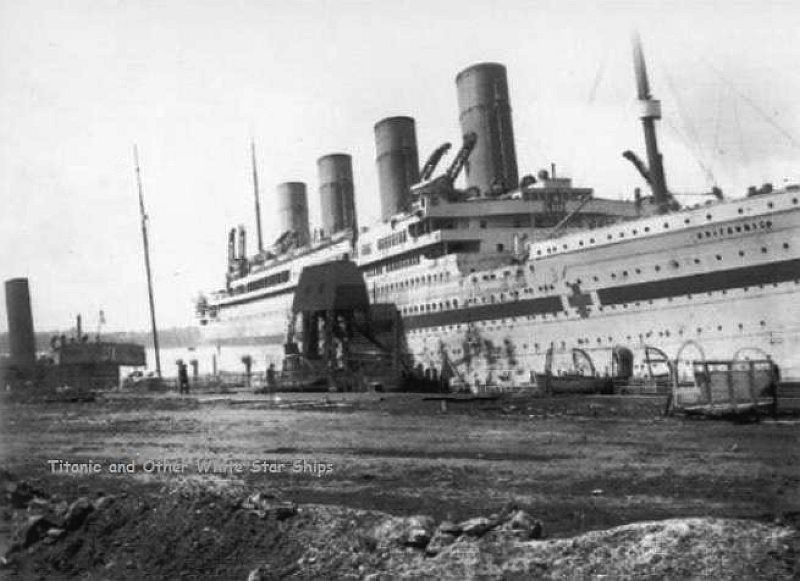
She
is seen here in Naples
loading coal
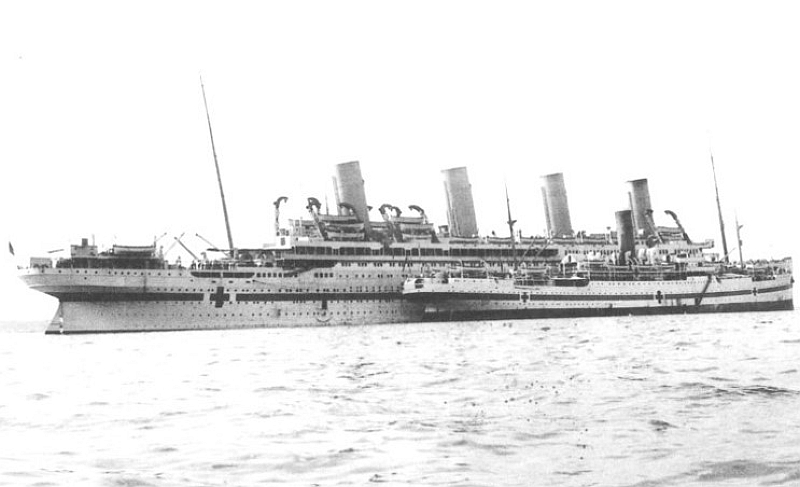
Here
we see the HMHS Britannic and the HMHS Galeka berthed alongside at Mudros, as
they transfer wounded soldiers and goods
These
smaller hospital ships would do the work in the local areas and transfer their wounded
to the larger ships as they arrive
Voyage 5:
October 20 –
Britannic departs Southampton for a direct
sailing for Mudros. On board she has additional medical personal and a large
stock of medical supplies which are to be used in Malta,
Egypt and in India! She
arrived at Mudros on October 28. Everything is offloaded and departs as soon as
possible with further wounded aboard and returns to Southampton
on November 6.
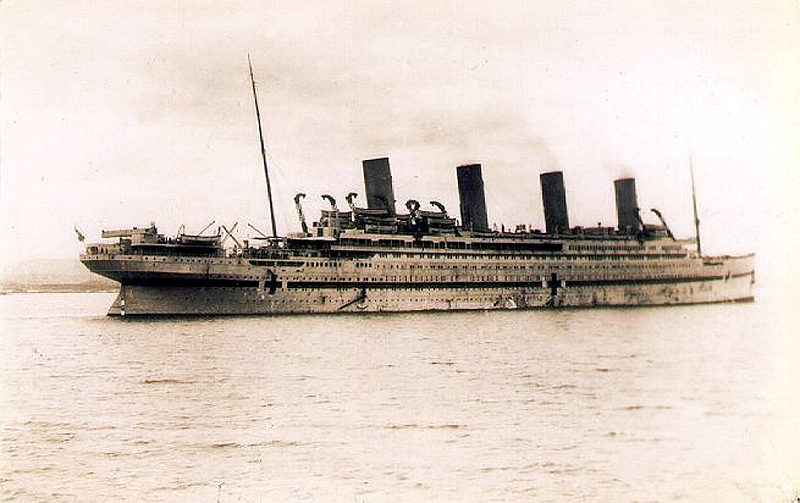
The
Britannic is looking somewhat worn, but she is a hard working ship!
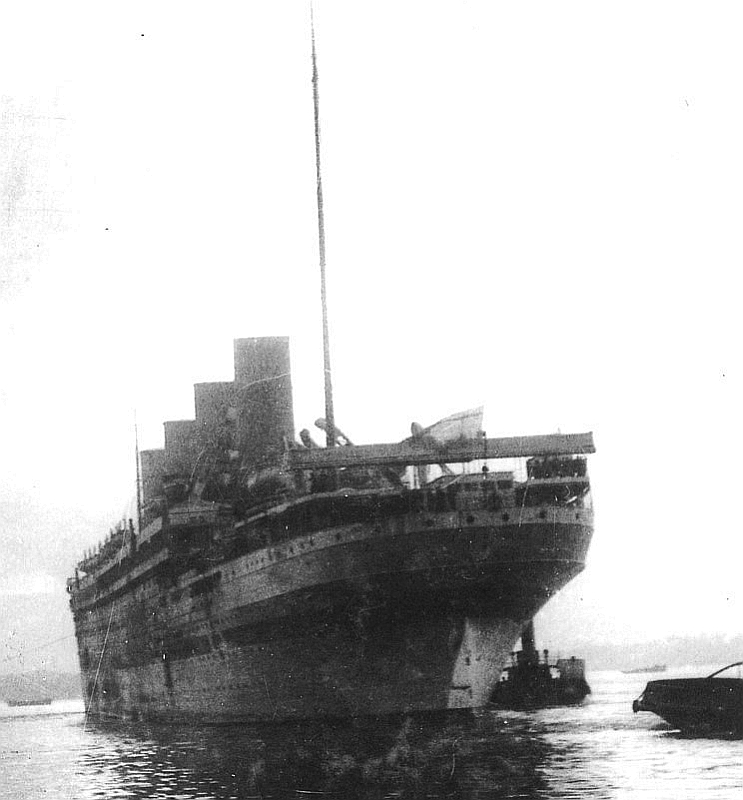
She
is seen here at Mudros during having offloaded the medical supplies onto barges
Voyage 6 – Her Final Voyage!
November 12 –
HMHS Britannic departed Southampton with a total of 1,066, being a medical
staff and crew, and she arrived at Naples
around 7 am on November 17, for it was here she would normally load coal.
However rather than departing on time in the
afternoon, she was held up, because of extreme bad weather conditions and she
departed three days late for Lemnos on
November 20. How different her history might have been IF she only been
able to depart on time, for the very next day November 21, 1916 would
be the magnificent Britannic’s very last day afloat!
6… Details of Her Final Days and
Tragic Voyage:
After completing
five successful voyages to the theatre of war and back to England transporting countless of ill and
wounded soldiers and others, the Britannic departed Southampton for Lemnos at
2.23 pm on November 12, 1916 being her sixth voyage to the Mediterranean.
The Britannic passed Gibraltar around midnight
on 15 November, she arrived at Naples at around
7 am on November 17, for Naples
was usually her coaling and water refuelling stop, thus it being the first port
of call on each voyage, except one. However, a storm stopped the ship from
departing until Sunday afternoon the 20th, as there was a break in the weather
and Captain Bartlett decided to take advantage of this quiet spell and sail.
The seas rose up again as soon as the Britannic had left port.
Tuesday November 21, 1916:
The following morning November 21 the storms
had thankfully gone and the seas were calm and Britannia had passed the Strait of Messina in the very early hours and without problems.
Next was Cape Matapan and that was rounded
during the first few hours of the day. Soon the Britannic was steaming at full
speed into the Kea Channel, between Cape
Sounion, which is the southernmost
point of Attica, the prefecture that includes Athens,
and the island
of Kea.
Whilst en-route to pick up patients off the
coast of Greece in the Kea
Channel at Lemnos, Mudros, the Britannic was
rocked without warning by a violent explosion and amazingly this great and
well-built ship sank in just 55 minutes! Here is what happened …
At 8:12 am on
November 21, without any warning there was a very loud explosion and the ship
was thrown instantly off-course by three points (33.75 degrees), whist her bow
rose noticeably and then came back down rapidly. During this, she suffered
severe shaking and vibrations along her hull. The actual cause was as yet
unknown, was it a torpedo from an enemy submarine or a mine. However as it
turned out, the ship had apparently hit a mine that had been laid that same
week by the U-Boat - U-73.
The reaction on board and those who were
having breakfast in the dining room was obviously immediate; doctors and nurses
departed for their posts. But as human nature is, not everyone reacted in the
same manner. Obviously further aft the power of the explosion was far less and
most thought the ship had hit an object, or even a smaller boat.
Captain Bartlett and Chief Officer Hume were
on the bridge at the time and the gravity of the situation very evident to
them. The explosion was on the starboard side, between holds two and three. The
force of the explosion damaged the watertight bulkhead between hold one and the
forepeak, thus the first four watertight compartments were filling rapidly with
water. In addition, the firemen’s tunnel that connected the
firemen’s quarters in the bow to boiler room number six was seriously
damaged, and therefore water would be flowing right into that boiler room.
Captain Bartlett ordered the watertight doors
closed immediately, sent a distress signal and ordered the crew to prepare the
lifeboats. Thankfully aboard Britannic there were sufficient lifeboats for all
on board, and even more if needed! Along with the damaged watertight door of
the firemen's tunnel, for some reason the watertight door between boiler rooms
six and five failed to close properly. Water was flowing further aft into
boiler room five and thus the great ship Britannic was quickly reaching her
flooding limit. She could stay afloat whilst motionless with her first six
watertight compartments flooded. There were five watertight bulkheads rising
all the way up to B-deck. Those measures had been taken after the Titanic
disaster. The next crucial bulkhead between boiler rooms five and four and its
door were undamaged and should have guaranteed the survival of the ship.
However, there were open portholes along the lower decks, which tilted
underwater within minutes of the explosion. The nurses had opened most of those
portholes to ventilate the wards. As the ship's list increased, water reached
this level and began to enter aft from the bulkhead between boiler rooms five
and four. With more than six compartments flooded, the Britannic would not be
able to stay afloat.
At 8.24 am the
Captain decided on a desperate measure and he ordered to restart the engines
and make an attempt to beach the ship.
At 8:25 am
lifeboats are still being filled but they are not allowed to leave. Yet without
authority some boats leave the ship from the portside and because of the list,
they are scraping along the ship's side. In addition as the ship is underway
again heading for the beach, the propellers are turning fast, and they are
breaking the surface by now.
At 8:35 am
things had increasingly become much worse and Captain Bartlett decided that
there was little time left, thus he brought the ship to a full halt and orders
“abandon ship” and all lifeboats to be lowered and sent away.
However, he is unaware that just a few minutes prior to his order that two unauthorised
lifeboats left the ship and were drawn into the portside propeller killing most
of the occupants, while a third one has a narrow escape as the propeller stops
seconds before impact. It is now
8:50 am whilst laying
idle the Britannic is settling more slowly and most of the lifeboats manage to
escape without further problems. Bartlett
decides to try again to beach the ship and restarts the engines. Britannic's
sinking rate increases again and water is soon reported forward on D-Deck.
9:00 am -
Captain Bartlett is informed of the water on D-Deck he gives the order to
abandon ship and Britannic’s horn is blown for the last time. Water has
by now reached the bridge and Assistant Commander Dyke informs his Captain that
all have left the ship. Dyke, Chief Engineer Fleming and Bartlett simply walk
towards the sea near the forward gantry davits. Shortly after their escape
funnel No.3 collapses.
9:04 am - as
the water is now 119 meters deep, Britannic's bow hits the bottom whilst the
stern is still above the surface. The last few men who were below decks not
seen by Assistant Commander Dyke have by now left the ship. Fifth Officer
Fielding estimates the stern rising some 150 feet into the air.
9:06 am - with
all her funnels detached, Britannic finally completes her starboard roll,
causing heavy damage to the forward bow area.
9:07 am –
The once majestic RMS – HMHS Britannic slips beneath the surface of the
clam sea landing goes down to her final resting place!

Image
above is © Copyright by Ken Marschall Visit Ken’s Web Site
at: www.trans-atlanticdesigns.com
Miss Violet Jessop who amazingly was also one of the survivors of the RMS Titanic, as
well as HMT Olympic, when the HMS Hawke collided with her, described
Britannic’s last seconds as follows:
“She dipped her head a little, then a
little lower and still lower. All the deck machinery fell into the sea like a
child's toys. Then she took a fearful plunge, her stern rearing hundreds of
feet into the air until with a final roar, she disappeared into the depths, the
noise of her going resounding through the water with undreamt-of violence....”
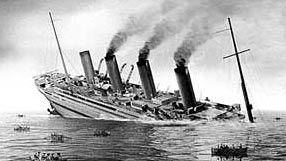
What is so amazing
is that all this occurred in calm weather and within sight of land and she sunk
in just 55 minutes, and having 1,066 crew and medical staff aboard, there were
only 30 deaths, and then these deaths were sadly related to those who were in
the two unauthorised lifeboats!
As I already indicated, the main cause of
deaths in this tragedy was, in fact, the premature lowering of two lifeboats,
which was done whilst the ship was moving in an attempt to beach her,
these two lifeboats were lowered before the official “abandon ship”
order was given and they were tragically dragged in by the powerful propellers
and destroyed causing deaths and injury to others. Eventually, the beaching
attempt was abandoned and the rest of the crew escaped to the lifeboats and to
shore. Fortunately, the ship was carrying no patients at the time of the
sinking, and thus the evacuation was made a great deal easier!
Today the cause of the sinking of the
Britannic is universally attributed to a German mine. However over the
years, there have been various theories, 1: that it was a torpedo, or 2: that
it was indeed a mine. Many somehow preferred the idea that it was hit by a
torpedo, because it would have been in violation of the Geneva
Convention. But, there is very little evidence to support the torpedo
theory. In addition it became soon known that German U-Boat U-73
had mined the channel that the Britannic passed only a few weeks prior the
sinking.
In addition, after a period of speculation the
mine theory was confirmed by U-73's commander Captain Siess’ log, that he
had only laid mines. And then there is the fact that the Union Castle
Line’s Breamar
Castle, also struck a mine in the same
region just two days later!
7… The Rescue of those on board
Britannic:
The first vessel to arrive on the
scene had some Greek fishermen from Kea on their Caïque, who picked up many men
from the water. One of them, Francesco Psilas, was later paid UK£4 pound by
the Admiralty for his services.
At 10.00 am – the HMS Scourge sighted the first lifeboats and ten minutes later stopped and
picked up 339 survivors.
HMS Heroic had
arrived some minutes earlier and picked up 494. Some 150 had made it to
Korissia, being a community on Kea, where surviving doctors and nurses from the
Britannic were trying to save the horribly mutilated men, using aprons and
pieces of lifebelts to make dressings. A little barren quayside served as their
operating room. Although the motor launches were quick to transport the wounded
to Korissia, the first lifeboat arrived there some two hours later because of
the strong current and their heavy load. It was the lifeboat of Sixth Officer
Welch and the unknown Officer. The latter was able to speak some French and
managed to talk with one of the local villagers, obtaining some bottles of
brandy and some bread for the injured.
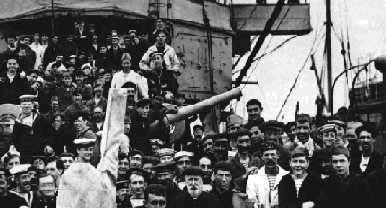
Here
we see some of the rescued crew on board the HMS Heroic
The inhabitants of Korissia were
deeply moved by the suffering of the wounded. They offered all possible
assistance to the survivors and hosted many of them in their houses while
waiting for the rescue ships. The HMS Scourge and HMS Heroic had no more deck
space to take further survivors and thus they soon departed for Piraeus signalling the
presence of those left at Korissia.
Violet Jessop
approached one of the wounded. “An elderly man, in an RAMC uniform with a
row of ribbons on his breast, lay motionless on the ground. Part of his thigh
was gone and one foot missing; the grey-green hue of his face contrasted with
his fine physique. I took his hand and looked at him. After a long time, he
opened his eyes and said: 'I'm dying'. There seemed nothing to disprove him yet
I involuntarily replied: 'No, you are not going to die, because I've just been
praying for you to live'. He gave me a beautiful smile - That man lived and sang
jolly songs for us on Christmas Day.”
11.45 am HMS Foxhound arrived and after sweeping the area she anchored in the small port
at 1.00 pm to offer medical assistance and took aboard the remaining survivors.
2.00 pm HMS Foresight a light cruiser arrived. The HMS Foxhound departed for Piraeus at 2.15 pm with
more survivors. The Foresight remained to arrange the burial on Kea of Sergeant
W. Sharpe, who had died of his injuries. Another two men died on the Heroic and
one on the French tug Goliath. The three were buried with military honours in
the British cemetery at Piraeus.
The last fatality was G. Honeycott, who died at the Russian
Hospital at Piraeus shortly after the funerals.
Thankfully out of the 1,066 souls on board.
1,036 people were saved, whilst some thirty men lost their lives in the
disaster, but only five were buried. The others were left in the water and
their memory is honoured in memorials in Thessaloniki
and London.
Another twenty-four men were injured. The ship carried no patients. The survivors
were hosted in the warships that were anchored at the port of Piraeus.
However, the nurses and the officers were hosted in separate hotels at
Phaleron. Many Greek citizens and officials were kind enough to attend the
funerals.
8…
Britannic’s Wreck Site:
The wreck of HMHS
Britannic is in Aegean Sea, some 2 miles northwest of Kea Island, Greece
(37.42N - 24.17E) in about 400 ft (120 m) of water. It was first
discovered and explored by Jacques Cousteau in 1975. The giant liner lies on
her starboard side hiding the impact with the mine. There is a huge hole just
beneath the forward well deck. The bow is attached to the rest of the hull only
by some pieces of the B-deck. This is the result of the massive explosion that
destroyed the entire part of the keel between bulkheads two and three and of
the force of impact with the seabed. The bow is heavily deformed as the ship
hit the seabed before the total length of the 882 feet 9 inches (269 m)
liner was completely submerged, as she sank in a depth of only 400 feet
(120 m) of water. Despite this, the crew's quarters in the forecastle were
found to be in good shape with many details still visible.
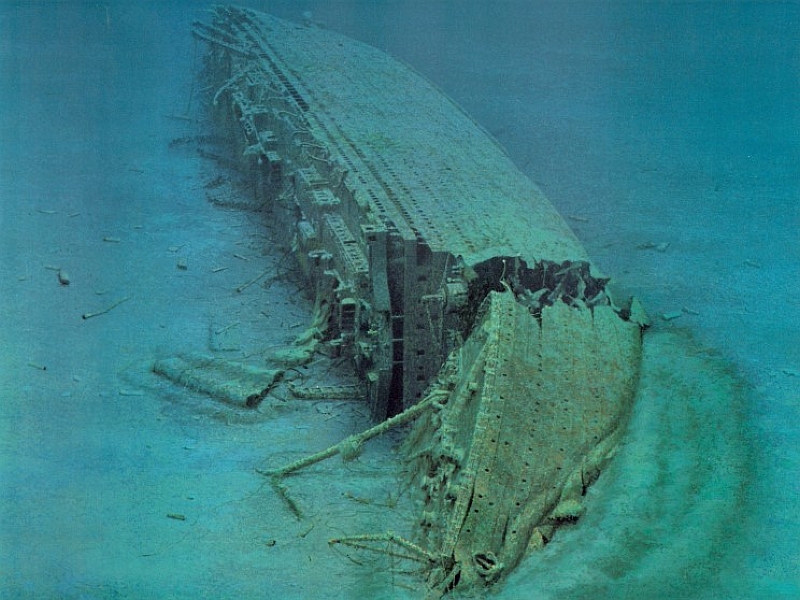
The Britannic seen on the floor of the ocean
Image above is ©
Copyright by Ken Marschall Visit Ken’s Web Site at: www.trans-atlanticdesigns.com
The holds were found
empty. The forecastle machinery and the two cargo cranes in the forward well
deck are still there and are well preserved. The foremast is bent and lies on
the sea floor near the wreck with the crow's nest still attached on it. The
bell was not found. Funnel #1 was found a few metres from the Boat Deck. The
other three funnels were found in the debris field (located off the stern). The
wreck lies in shallow enough water that scuba divers trained in technical
diving can explore it, but it is listed as a British war grave and any
expedition must be approved by both the British and Greek governments.
RMS
Britannic Specifications as a Passenger Liner:
Built
by: Harland & Wolff, Belfast.
Yard: 401.
Laid down: November 30, 1911.
Launched: February 26, 1914.
During fit-out: Converted as a Hospital Ship.
Completed: December 8, 1915.
Maiden Voyage: December 23, 1915 for the British
Admiralty.
Tonnage: 48,158 GRT (Gross Registered
Tons).
Displacement: 52,310 tons
at 34.7ft.
Length: 259.7m - 903ft.
Width: 28.65m - 94ft.
Draught: 34.6ft
– 10.54.
Engines: 2 four
cylinder triple expansion (outside props).
1
Parsons low pressure steam turbine (center prop)
Boilers: 24 Double ended – 5
Single ended – coal fired.
Funnels: 4.
Masts: 2.
Screws: Triple - 51,000 IHP.
Shafts: 3
Speed: 21 knots service speed
– 22.5 knots max.
Passengers: 790 First Class. 836 Second Class.
953 Third Class.
Officers & Crew: 930.
As
HMHS Britannic – Hospital Ship:
Wounded: 3,300.
Medical staff: 437.
Officers & Crew: 724.
Final Voyage: 1,066 persons on board.
**************************************************
Let
us Remember the Britannic and NEVER Forget
Her!
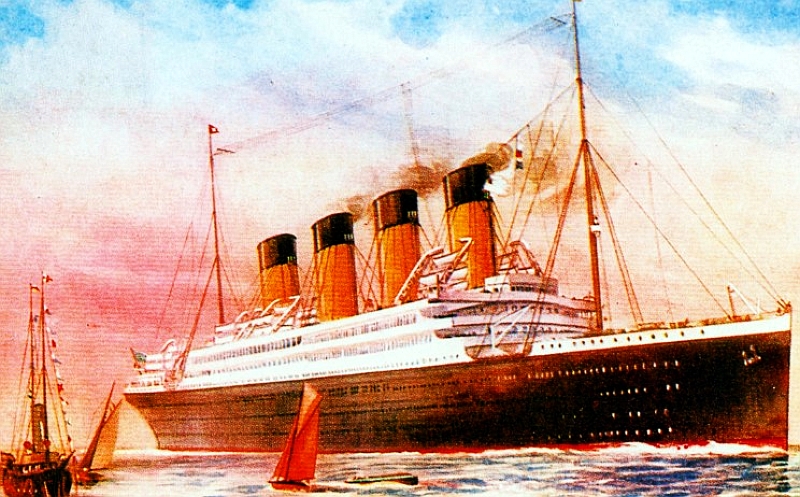
This is how we should really remember this truly
great ship as she would have looked like had she sailed the Atlantic!
RMS Britannic was a superbly built liner and
she would have been great if she would have been allowed to sail on for many
more years, like her successful sister the RMS Olympic for many years, but
instead the elegant HMHS Britannic sailed and cared for tens of thousands of
wounded soldiers for just under eleven months and then
she fell victim to a German laid mine.
****************************
Also
read my two page feature on the RMS Olympic
- “Old Reliable”
& the RMS Titanic!
RMS Olympic … Olympics’
History Page & Interior Photographs - in service
1911 to 1935.
RMS Titanic … Two Page Titanic feature with photographs.
HMHS Britannic … The Britannic story -
in service 1915 to 1916 - (This Page).
“Blue Water Liners sailing to the distant shores.
I watched them come, I watched them go and I watched them die.”
****************************
Visit our ssMaritime - Main INDEX
Where
you will discover over 700 Classic Passenger & Passenger-Cargo Liners!
ssMaritime.com & ssMaritime.net
Where
the ships of the past make history
&
the 1914 built MV Doulos Story
Please
Note: ssmaritime and associated sites are 100%
non-commercial and the author does not seek funding or favours and never have
and never will.
Photographs
on ssmaritime and associate pages are either by the author or from the
author’s private collection. In addition there are some images and
photographs that have been provided by Shipping Companies or private
photographers or collectors. Credit is given to all contributors, however,
there are some photographs provided to me without details regarding the
photographer or owner concerned. Therefore, I hereby invite if owners of these
images would be so kind to make them-selves known to me (my email address can
be found at the bottom of the page on www.ssmaritime.com), in order that due credit may be given.
ssMaritime is owned &
© Copyright by Reuben Goossens - All Rights Reserved
































